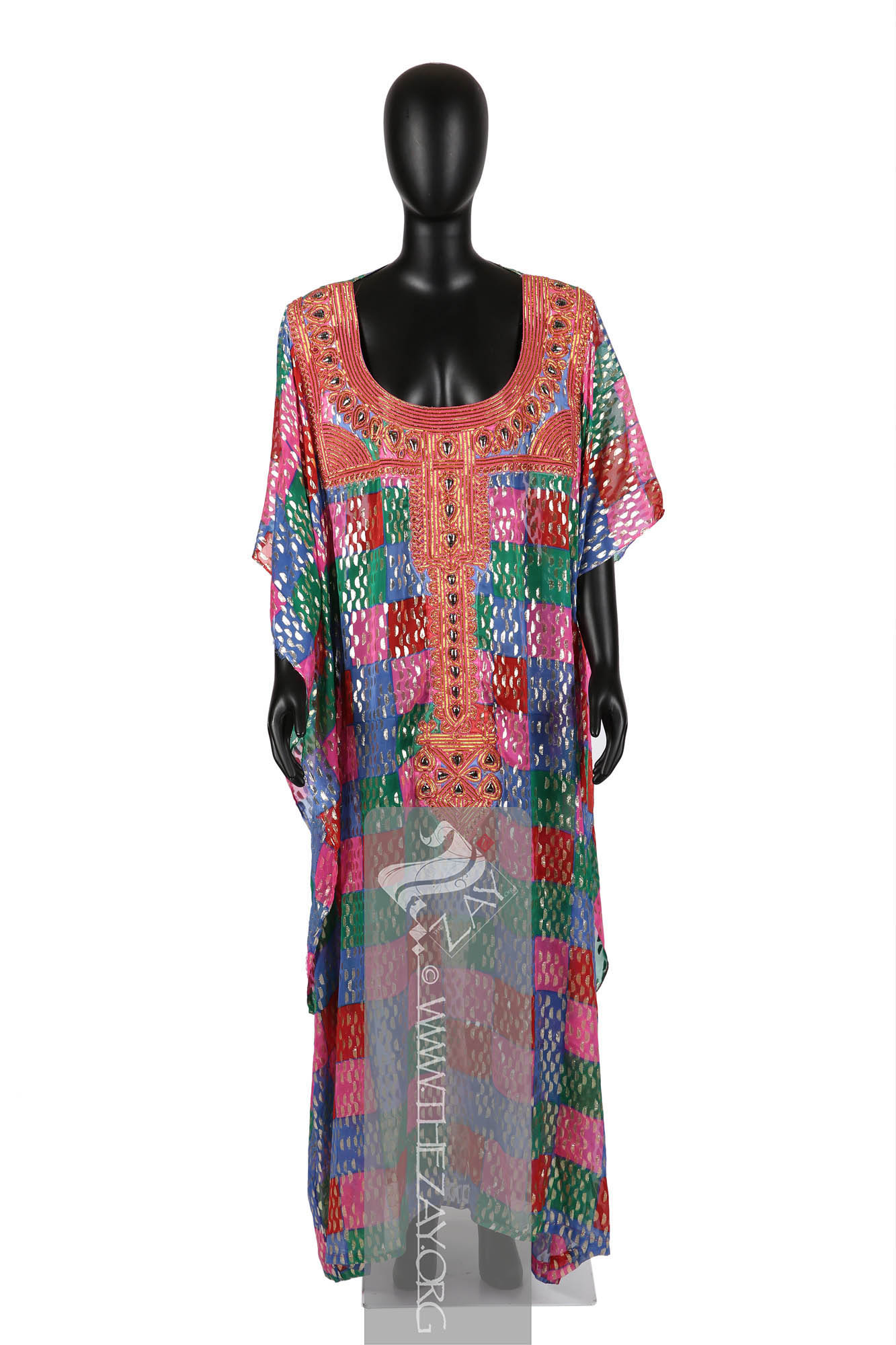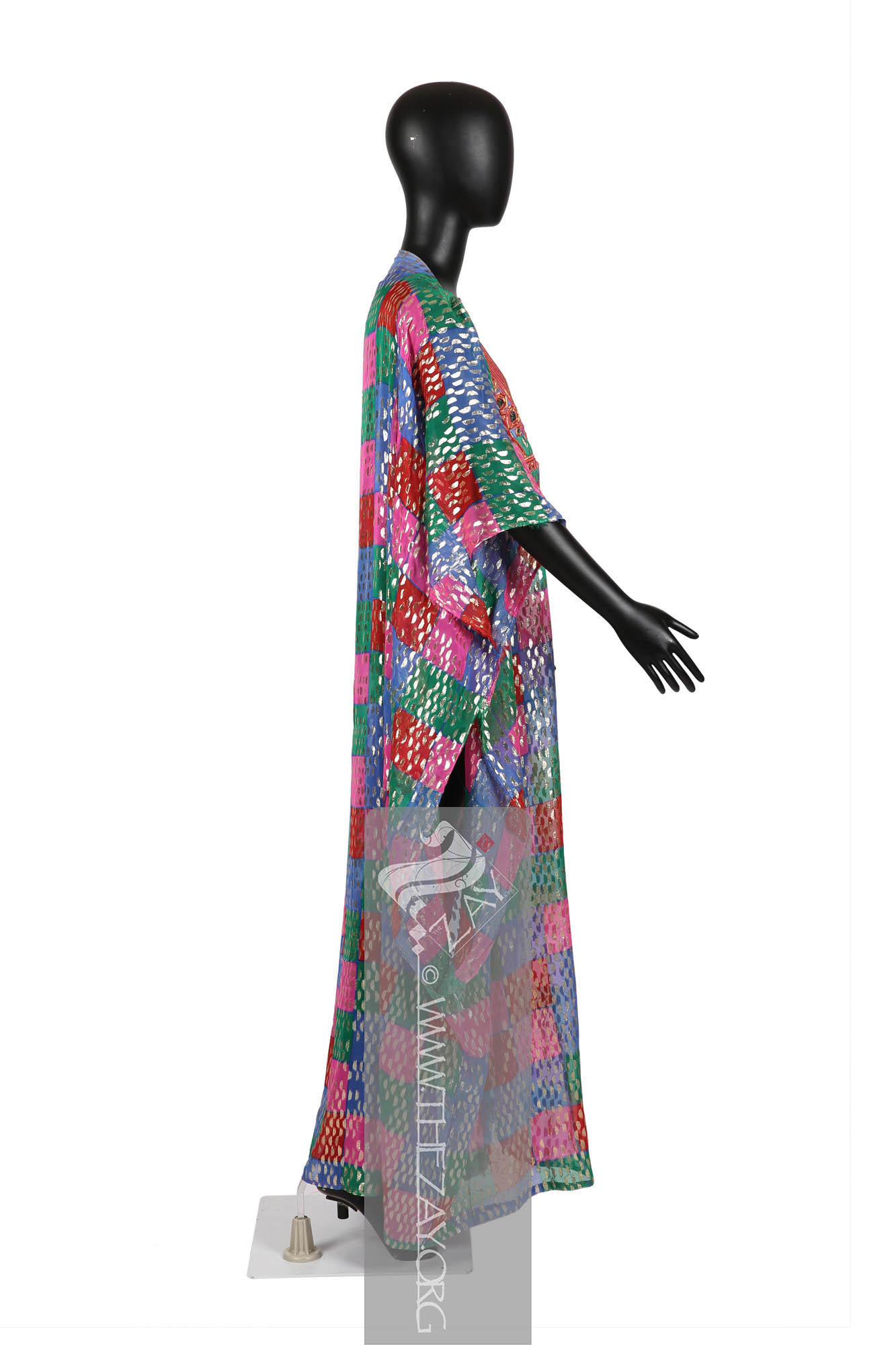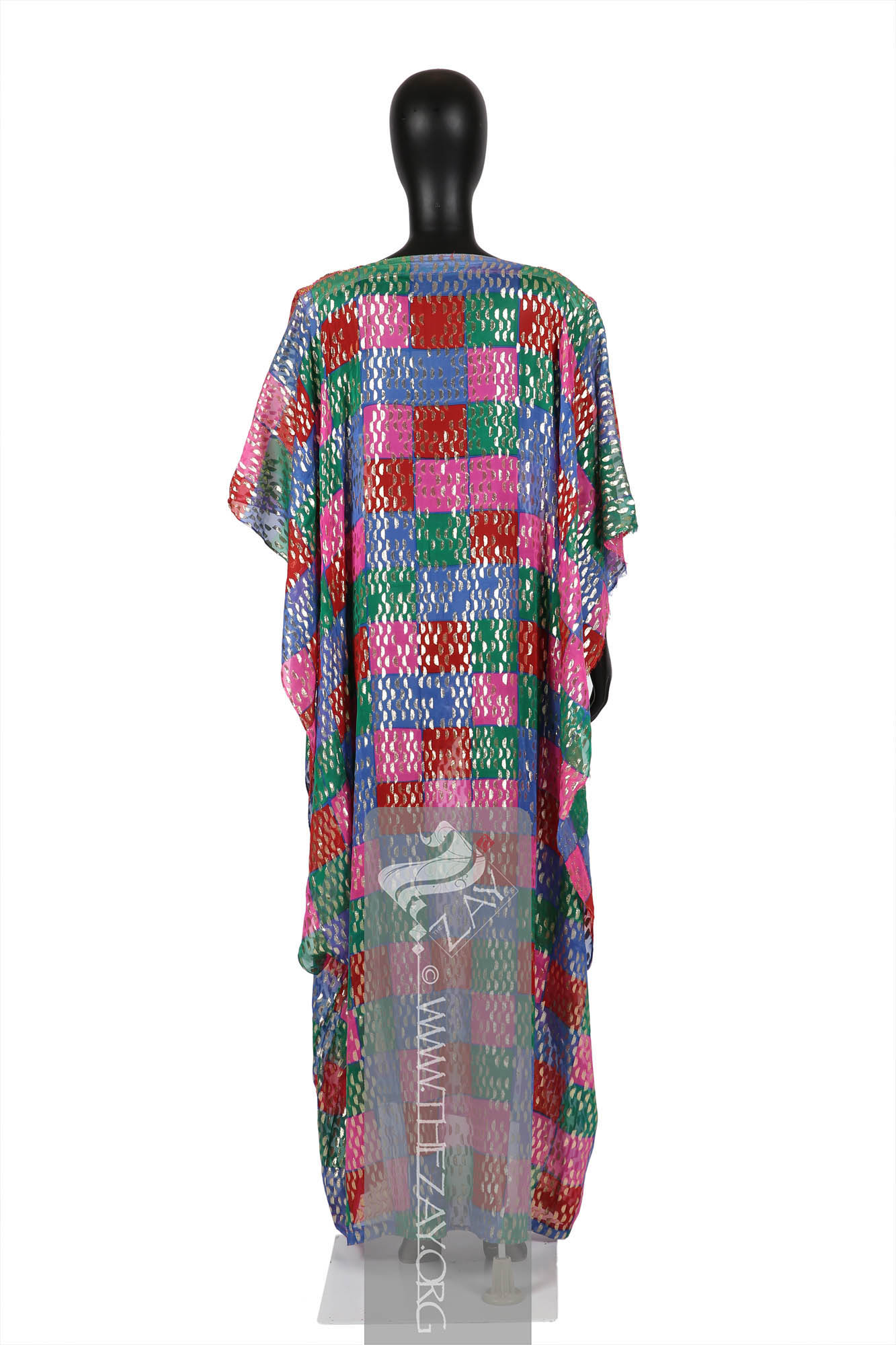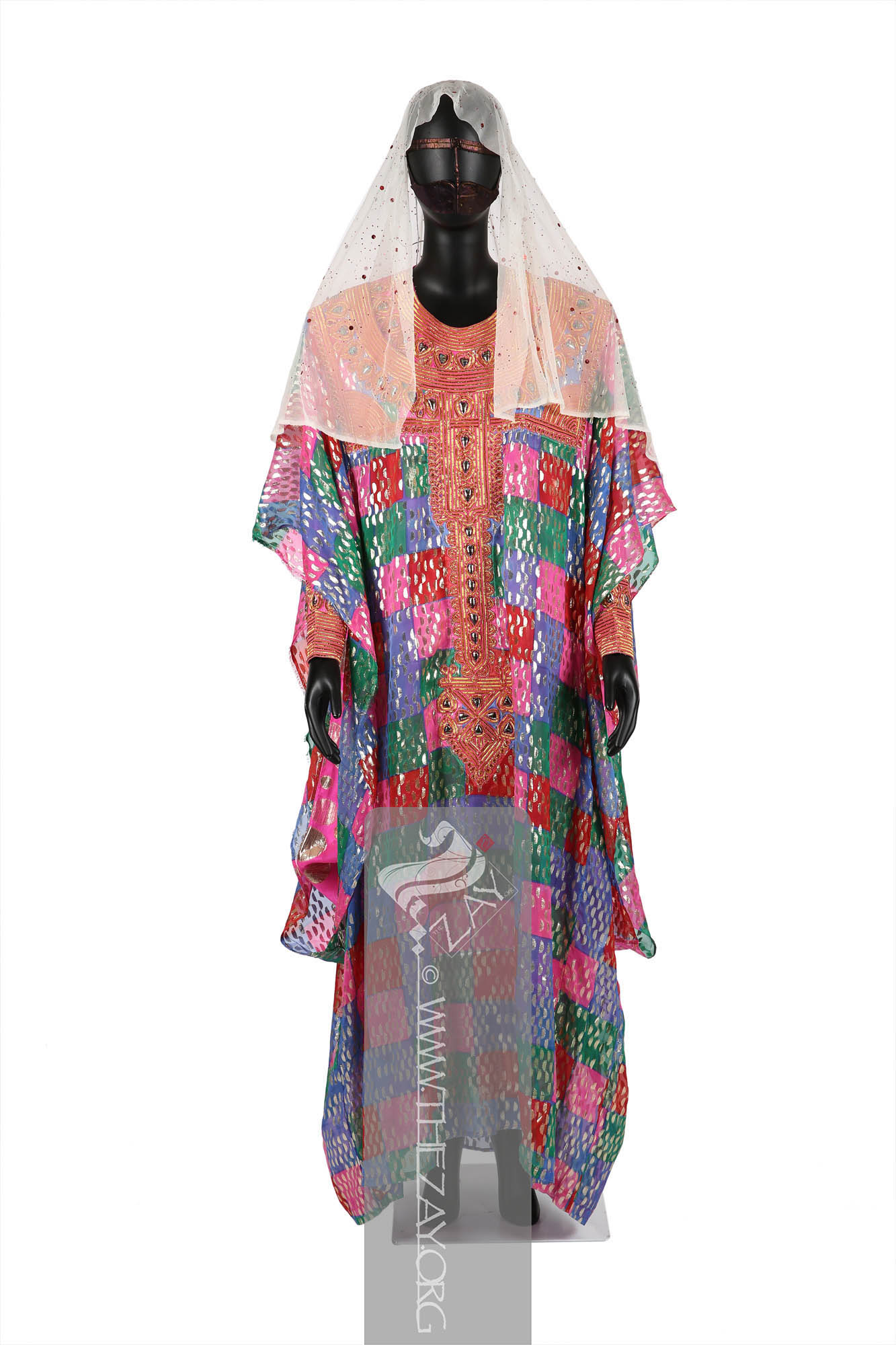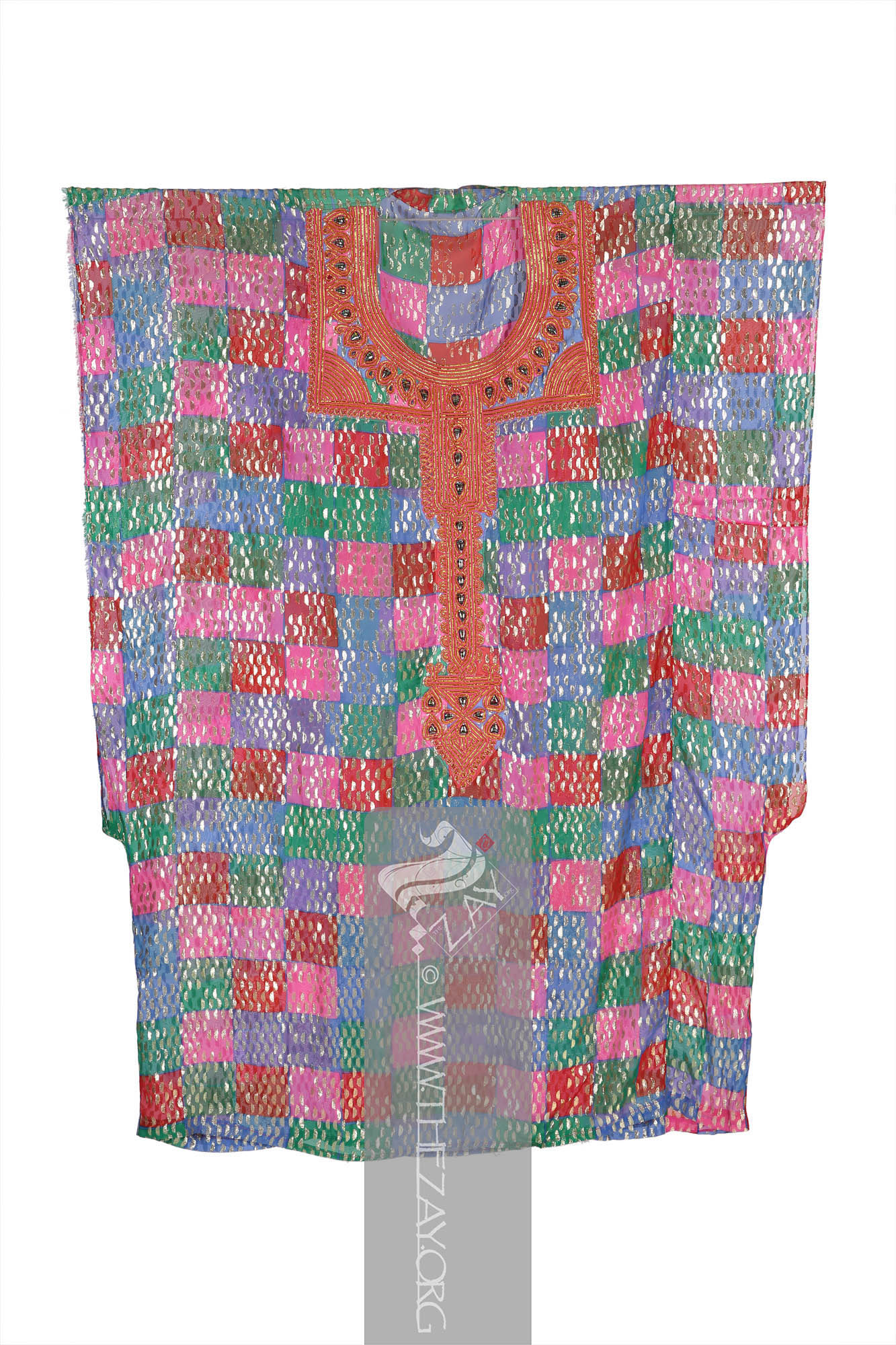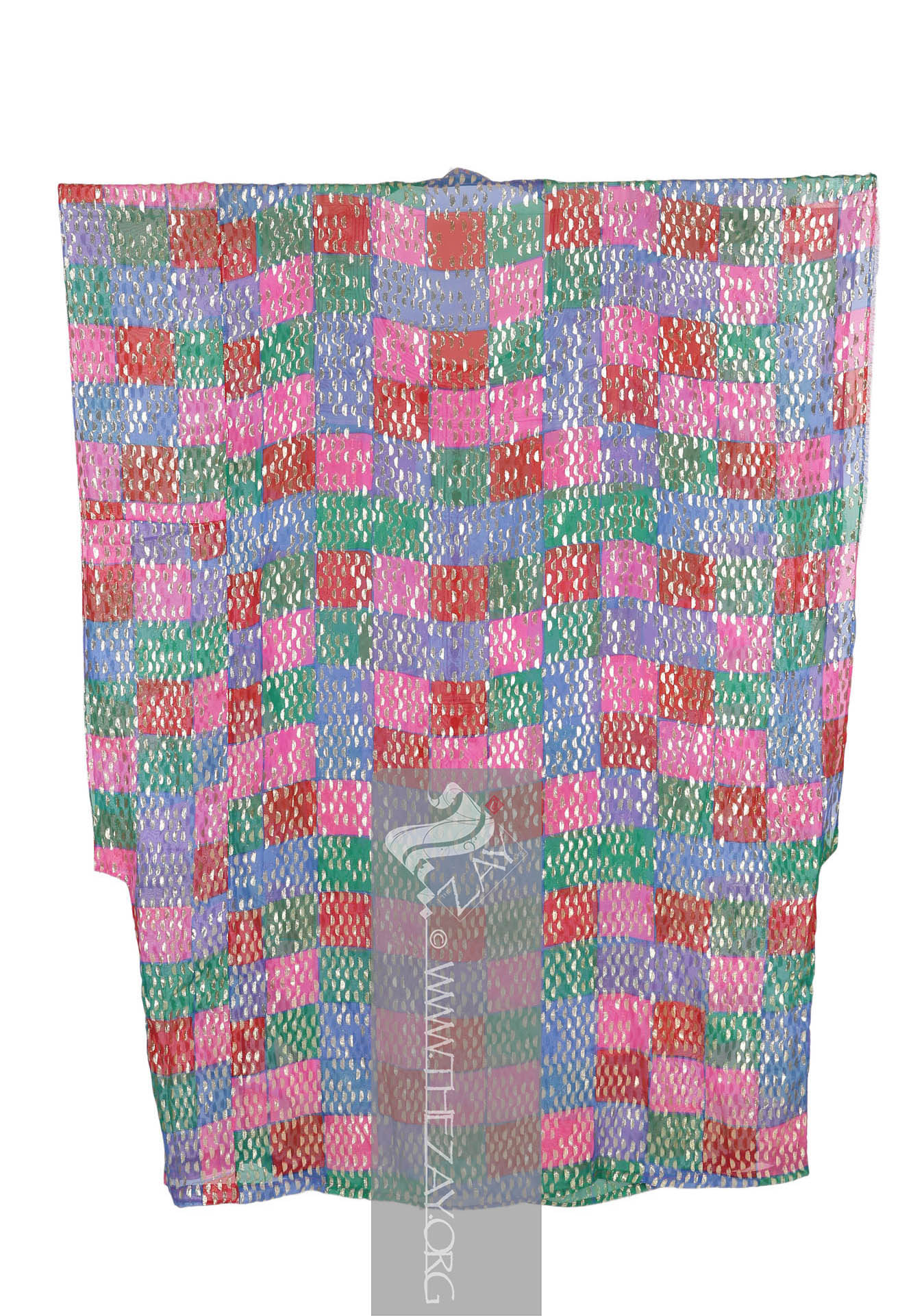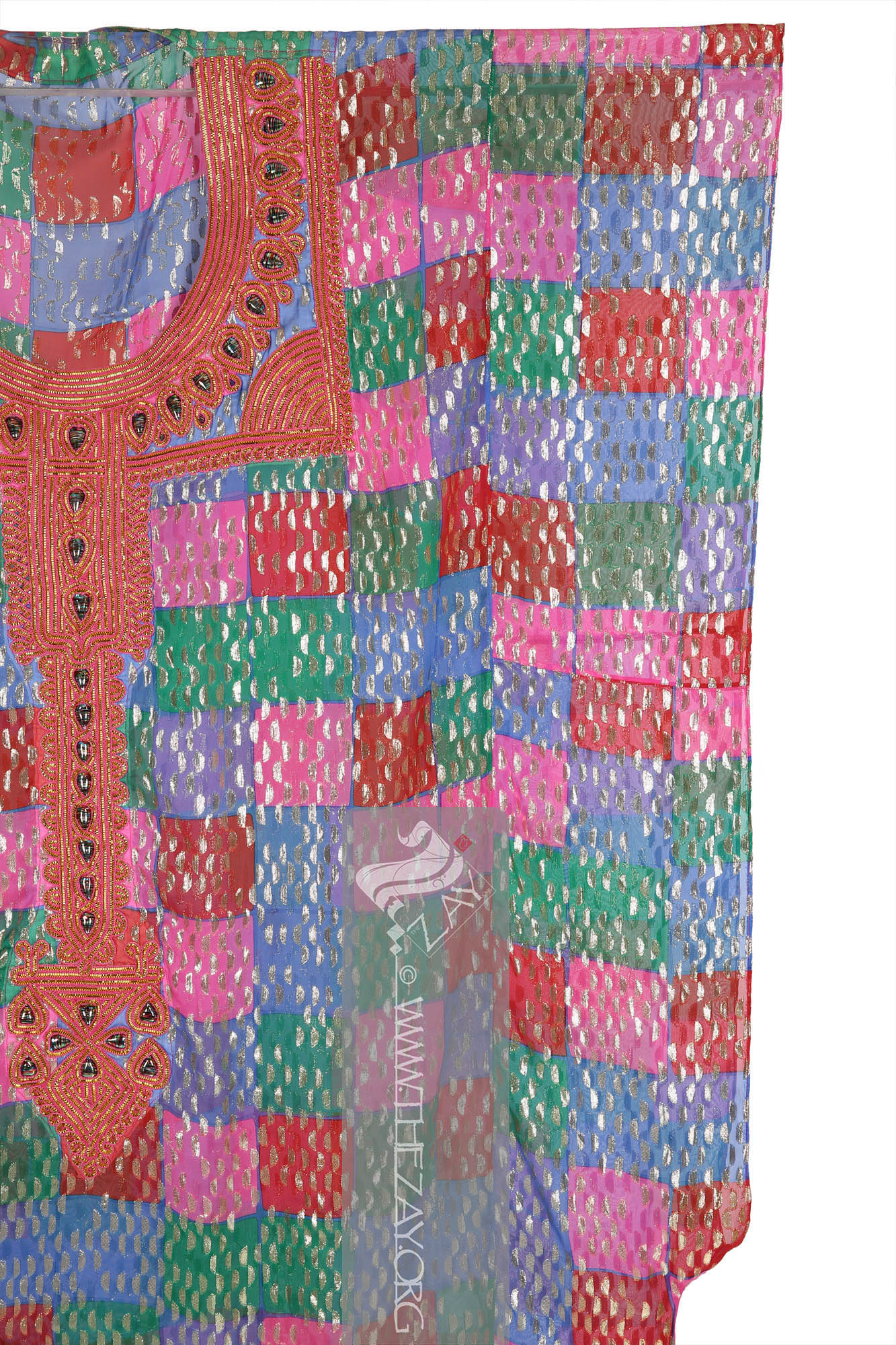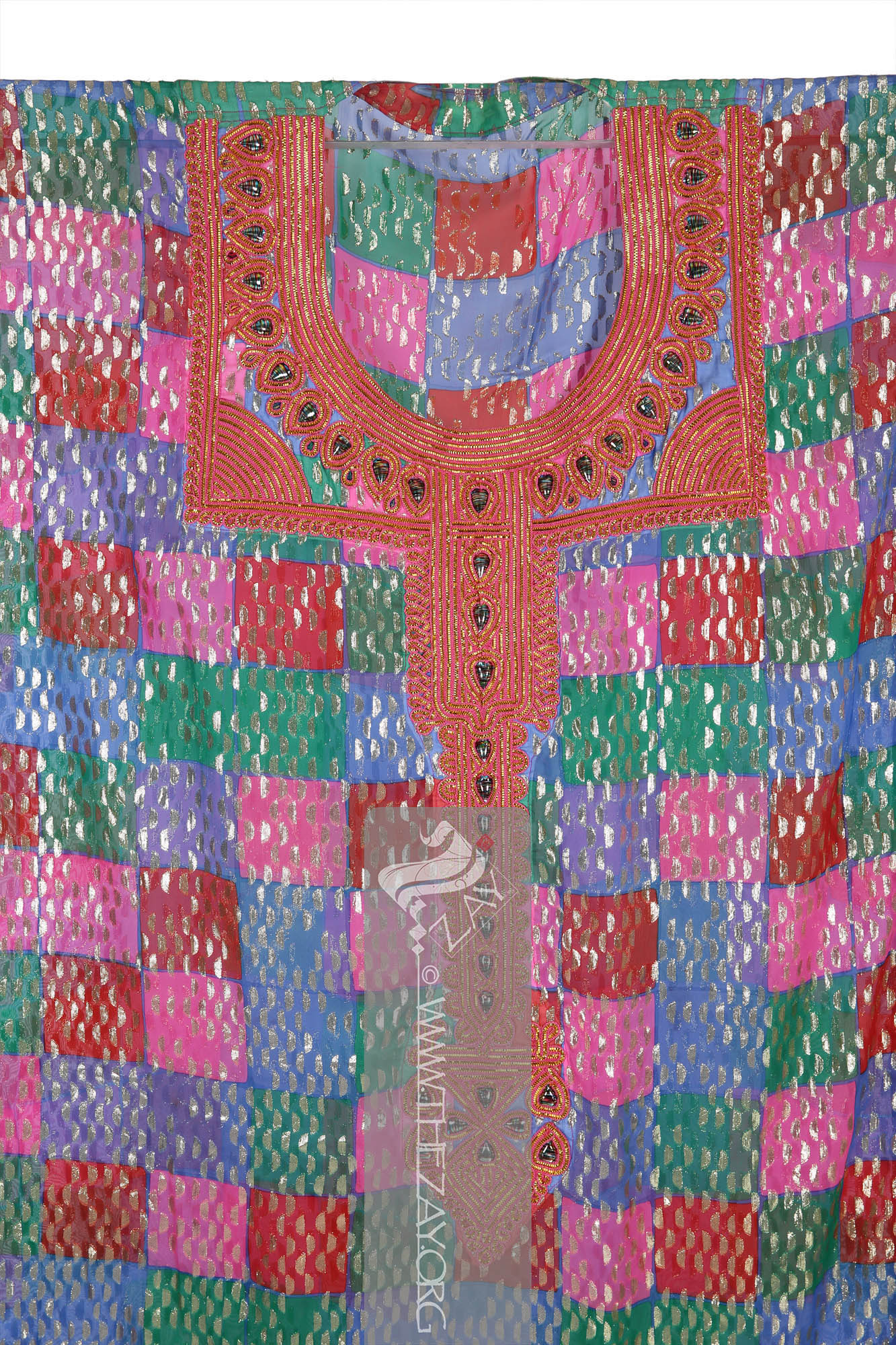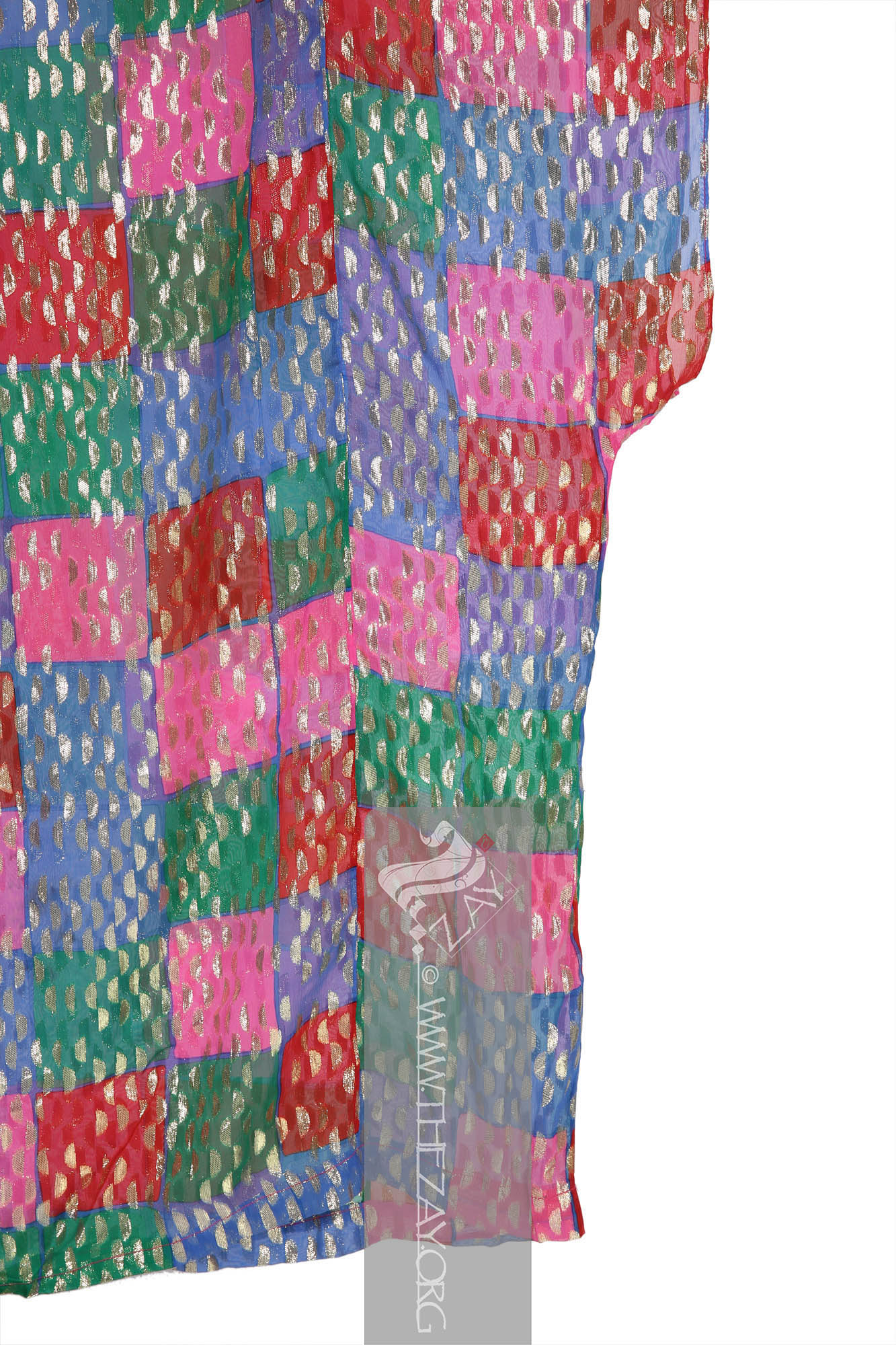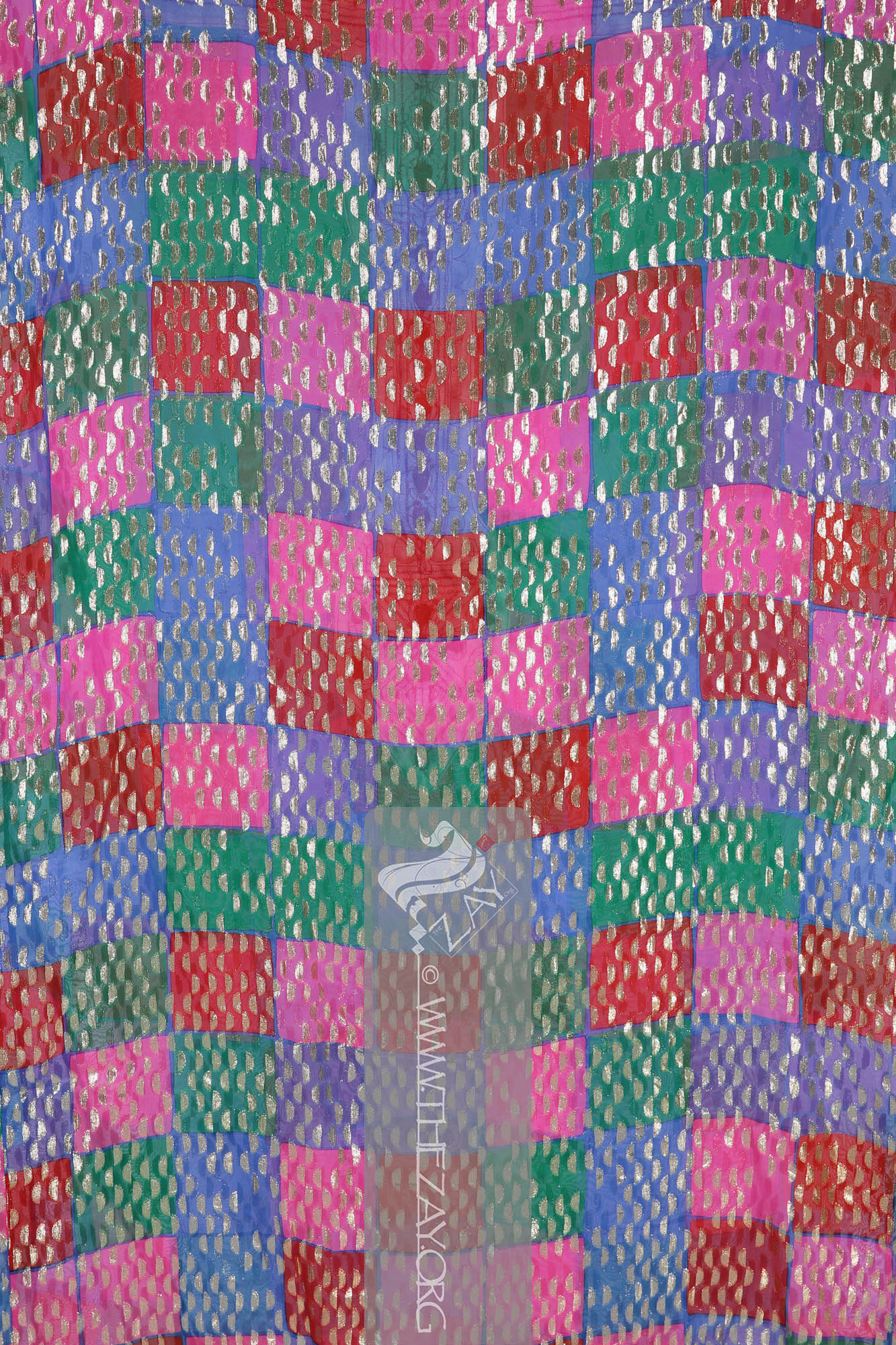Embellished overgarment in metallic straw - UAE
| Local Name | Thawb mkhawas talli rainbow |
| Object Category | Overgarment |
| Gender | Female |
| Date of object | 1980 |
| Place Of orgin | United Arab Emirates |
| Region | Abu Dhabi |
| Object Range | United Arab Emirates |
| Dimensions | Length: 143 cm Width: 111 cm |
| Materials | Silk |
| Technique | Machine Stitched Embellished |
| Motif | Geometric |
| Provenance | Gifted, Sheikha Salama bint Hamdan Al Nahyan, Abu Dhabi 1980 |
| Location | Zay
Zay: (Arabic: costume, Pl. azyaā’), a set of clothes in a style typical of a particular country or historical period. Initiative |
| Status | In storage |
| ZI number | ZI1980.50047 UAE |
Object Note
This overgarment (thawb
Thawb: (Arabic: thawb, Pl. Athwāb/thībān), can be pronounced thobe
Thobe: (Arabic: thawb, Pl. Athwāb/thībān), can be pronounced thawb or tobe
Tobe: (Arabic: thawb, Pl. Athwāb/thībān), can be pronounced thawb or thobe based on locale. The standard Arabic word for ‘fabric’ or ‘garment’. It can refer to a qamīs-like tunic worn by men and women in the Arabian Peninsula, Iraq, the southern and south-western ports and islands of Iran, and some countries in East and West Africa. More specifically, it can refer to the square-shaped Bedouin overgarment worn by women. based on locale. The standard Arabic word for ‘fabric’ or ‘garment’. It can also refer to a qamīs-like tunic worn by men and women in the Arabian Peninsula, Iraq, the southern and south-western ports and islands of Iran, and some countries in East and West Africa. More specifically, it can refer to the square-shaped Bedouin overgarment worn by women. or tobe
Tobe: (Arabic: thawb, Pl. Athwāb/thībān), can be pronounced thawb or thobe based on locale. The standard Arabic word for ‘fabric’ or ‘garment’. It can refer to a qamīs-like tunic worn by men and women in the Arabian Peninsula, Iraq, the southern and south-western ports and islands of Iran, and some countries in East and West Africa. More specifically, it can refer to the square-shaped Bedouin overgarment worn by women. based on locale. The standard Arabic word for ‘fabric’ or ‘garment’. It can also refer to a qamīs-like tunic worn by men and women in the Arabian Peninsula, Iraq, the southern and south-western ports and islands of Iran, and some countries in East and West Africa. More specifically, it can refer to the square-shaped Bedouin overgarment worn by women in the Arabian Gulf region. ) is part of an ensemble (thawb_wa_kandurah
Thawb_wa_kandūrah: (colloquial, UAE), an elaborate form of the traditional overgarment (thawb
Thawb: (Arabic: thawb, Pl. Athwāb/thībān), can be pronounced thobe
Thobe: (Arabic: thawb, Pl. Athwāb/thībān), can be pronounced thawb or tobe
Tobe: (Arabic: thawb, Pl. Athwāb/thībān), can be pronounced thawb or thobe based on locale. The standard Arabic word for ‘fabric’ or ‘garment’. It can refer to a qamīs-like tunic worn by men and women in the Arabian Peninsula, Iraq, the southern and south-western ports and islands of Iran, and some countries in East and West Africa. More specifically, it can refer to the square-shaped Bedouin overgarment worn by women. based on locale. The standard Arabic word for ‘fabric’ or ‘garment’. It can also refer to a qamīs-like tunic worn by men and women in the Arabian Peninsula, Iraq, the southern and south-western ports and islands of Iran, and some countries in East and West Africa. More specifically, it can refer to the square-shaped Bedouin overgarment worn by women. or tobe
Tobe: (Arabic: thawb, Pl. Athwāb/thībān), can be pronounced thawb or thobe based on locale. The standard Arabic word for ‘fabric’ or ‘garment’. It can refer to a qamīs-like tunic worn by men and women in the Arabian Peninsula, Iraq, the southern and south-western ports and islands of Iran, and some countries in East and West Africa. More specifically, it can refer to the square-shaped Bedouin overgarment worn by women. based on locale. The standard Arabic word for ‘fabric’ or ‘garment’. It can also refer to a qamīs-like tunic worn by men and women in the Arabian Peninsula, Iraq, the southern and south-western ports and islands of Iran, and some countries in East and West Africa. More specifically, it can refer to the square-shaped Bedouin overgarment worn by women in the Arabian Gulf region. ) and tunic (kandūrah) ensemble, that evolved post-1980s where the two garments became matched as a set.) and worn with the matching tunic dress (kandurah_arabiyah
Kandūrah_‘arabīyah: (colloquial Emirati term), coined post 1990s, to refer to the qamīs-like tunic with vertical slit located on the left side of the neckline extending down the chest. The origins of this slit are believed to lie in the Punjabi (kurta) and is generally fastened using cotton thread ball-like buttons ('igham), or metal snaps (siq_w_bic) which were subsequently replaced by transparent versions.ly replaced by transparent versions. talli
Tallī: (Arabic: talā, or talā’: paint or to coat, Turkish: tel: wire, synonyms: asīūṭī, tur_bi_tallī/tulle_bi_talli
Tulle_bi_tallī: (English: tulle: netting, Arabic: talā, or talā’: paint or to coat, Turkish: tel: wire, synonyms: asūṭī, tallī, tur_bi_talli, mnaqad/mnaghad, mukaish
Mukaish (Indian, synonyms: asūṭī, tallī, tur_bi_tallī/tulle_bi_talli, mnaqad/mnaghad, mukaish, badla/badlah, fardi, khus_dozi
Khūs_dozi: (Persian: Khus – Gold; Dozi – sewing or embroidery), any embroidery that is done with gold wire or thread. ). Indian embroidery technique where small rectangular strips of metal are squeezed shut around some threads of the fabric creating intricate shapes and designs., badla/badlah, fardi, khus_dozi
Khūs_dozi: (Persian: Khus – Gold; Dozi – sewing or embroidery), any embroidery that is done with gold wire or thread. ). Cotton linen or synthetic mesh hand embellished with flat strips of metal alloys coated with silver or gold squeezed shut around some threads of fabric creating intricate shapes and designs., mnaqad/mnaghad, mukaish
Mukaish (Indian, synonyms: asūṭī, tallī, tur_bi_tallī/tulle_bi_talli, mnaqad/mnaghad, mukaish, badla/badlah, fardi, khus_dozi
Khūs_dozi: (Persian: Khus – Gold; Dozi – sewing or embroidery), any embroidery that is done with gold wire or thread. ). Indian embroidery technique where small rectangular strips of metal are squeezed shut around some threads of the fabric creating intricate shapes and designs., badla/badlah, fardi, khus_dozi
Khūs_dozi: (Persian: Khus – Gold; Dozi – sewing or embroidery), any embroidery that is done with gold wire or thread. ), metal alloys coated with silver or gold, to create either flat straws or coil threads applied on clothing in varying patterns. rainbow
Rainbow: (English: rainbow). Colloquially, in the UAE the term denotes to rainbow lustre be it on crystal or metallic straw used for embellishing articles of dress. ) (ZI1980.50047a UAE).
Object History
This ensemble was commissioned by Sheikhah Salama bint Hamdan Al Nahyan from the late Fatima bint Saad, a renowned palace dressmaker. Sheikhah Salama is the wife of Sheikh Mohammed bin Zayed Al Nahyan, the crown prince of the Emirate of Abu Dhabi and Deputy Supreme Commander of the United Arab Emirates Armed Forces. She is a childhood friend of Dr. Reem Tariq El Mutwalli
Dr. Reem Tariq el Mutwallī: Founder (CEO) of the Zay
Zay: (Arabic: costume, Pl. azyaā’), a set of clothes in a style typical of a particular country or historical period. Initiative, a public figure, speaker and author. An expert curator and consultant in Islamic art and architecture, interior design, historic costume, and UAE heritage..
The dress was designed for the elite as occasion wear and Dr. Reem watched her friend wear it on many different social occasions before it was gifted to her. She in turn wore it through the 1990s before it became an early, core part of the Zay
Zay: (Arabic: costume, Pl. azyaā’), a set of clothes in a style typical of a particular country or historical period. Collection.
Object Features
The main fabric is light French silk chiffon with green, fuchsia (busi
Būṣī: (UAE colloquial), the colour fuschia.), red, and blue chequered motif with gold brocading (mkhawas
Mkhawaṣ: (Arabic: khuṣ) meaning adorned with straw (khūṣ). Adding the letter (mīm) to the start of the word changes the meaning to ‘decorated with’. Also known as (mzarāī) or (mgaṣab).) or (mzarai
Mzarāī : (Persian, originally two-syllables: zar-dozi, zar: gold, dozi: embellishment). Colloquial in the Arab Gulf region, it refers to any gold brocaded fabric or gilded embellishment. The flat ribbons or straws are known as (zari
Zarī: (Persian two-syllables: zar: gold & dozi: embellishment), complex embroidery technique that uses metal alloy on silk, satin, or velvet, and may include pearls, beads, and precious stones. Colloquially in the Arab gulf region, the term (zarī) is loosely applied to any gilded thread, embellishment or gilded brocade fabric. Originated in ancient Persia it has been used extensively in Indian and Middle Eastern textiles for centuries. ), (khus), or (gasab
Gaṣab: (Arabic: qaṣab: straw). Colloquial in Arabic the letter (qaf) is turned to (ga).). Adding the letter (mīm) to the start of the word changes the meaning to ‘decorated with’. Also known as, (mkhawas
Mkhawaṣ: (Arabic: khuṣ) meaning adorned with straw (khūṣ). Adding the letter (mīm) to the start of the word changes the meaning to ‘decorated with’. Also known as (mzarāī) or (mgaṣab).) or (mgasab
Mgaṣṣab: (Arabic: qasab), meaning decorated in straw (gasab). Colloquial in the Arabic the letter (qaf) is turned to (ga). Adding the letter (mīm) to the start of the word changes the meaning to ‘decorated with’. Also known as (mzarāī) or (mkhawas
Mkhawaṣ: (Arabic: khuṣ) meaning adorned with straw (khūṣ). Adding the letter (mīm) to the start of the word changes the meaning to ‘decorated with’. Also known as (mzarāī) or (mgaṣab).).).). The neckline (halj
Ḥalj: (Arabic: ḥalq: mouth, pl: ḥlūj,). Colloquially, the term refers to the neckline opening. The letter (qāf) is turned (jīm) in many Arab dialects.) and the chest area (bidhah
Bidḥah: (Arabic: qata'a or shaqqa: to cut or split). In Emirati dialect, the term refers to the chest area of a garment generally decorated in embroidery or other embellishments.) are adorned with (talli
Tallī: (Arabic: talā, or talā’: paint or to coat, Turkish: tel: wire, synonyms: asīūṭī, tur_bi_tallī/tulle_bi_talli
Tulle_bi_tallī: (English: tulle: netting, Arabic: talā, or talā’: paint or to coat, Turkish: tel: wire, synonyms: asūṭī, tallī, tur_bi_talli, mnaqad/mnaghad, mukaish
Mukaish (Indian, synonyms: asūṭī, tallī, tur_bi_tallī/tulle_bi_talli, mnaqad/mnaghad, mukaish, badla/badlah, fardi, khus_dozi
Khūs_dozi: (Persian: Khus – Gold; Dozi – sewing or embroidery), any embroidery that is done with gold wire or thread. ). Indian embroidery technique where small rectangular strips of metal are squeezed shut around some threads of the fabric creating intricate shapes and designs., badla/badlah, fardi, khus_dozi
Khūs_dozi: (Persian: Khus – Gold; Dozi – sewing or embroidery), any embroidery that is done with gold wire or thread. ). Cotton linen or synthetic mesh hand embellished with flat strips of metal alloys coated with silver or gold squeezed shut around some threads of fabric creating intricate shapes and designs., mnaqad/mnaghad, mukaish
Mukaish (Indian, synonyms: asūṭī, tallī, tur_bi_tallī/tulle_bi_talli, mnaqad/mnaghad, mukaish, badla/badlah, fardi, khus_dozi
Khūs_dozi: (Persian: Khus – Gold; Dozi – sewing or embroidery), any embroidery that is done with gold wire or thread. ). Indian embroidery technique where small rectangular strips of metal are squeezed shut around some threads of the fabric creating intricate shapes and designs., badla/badlah, fardi, khus_dozi
Khūs_dozi: (Persian: Khus – Gold; Dozi – sewing or embroidery), any embroidery that is done with gold wire or thread. ), metal alloys coated with silver or gold, to create either flat straws or coil threads applied on clothing in varying patterns.) work of red cotton threads (hdub
Hdūb: (Arabic: hadb: eyelash), in colloquial UAE, the term refers to any fringe on a garment.) and gold metallic straw (khus
Khūṣ: (Arabic: straw, sing. khūṣah), flat silver or metallic flat straw used in embroidery or tallī making.) created in a style known as talli
Tallī: (Arabic: talā, or talā’: paint or to coat, Turkish: tel: wire, synonyms: asīūṭī, tur_bi_tallī/tulle_bi_talli
Tulle_bi_tallī: (English: tulle: netting, Arabic: talā, or talā’: paint or to coat, Turkish: tel: wire, synonyms: asūṭī, tallī, tur_bi_talli, mnaqad/mnaghad, mukaish
Mukaish (Indian, synonyms: asūṭī, tallī, tur_bi_tallī/tulle_bi_talli, mnaqad/mnaghad, mukaish, badla/badlah, fardi, khus_dozi
Khūs_dozi: (Persian: Khus – Gold; Dozi – sewing or embroidery), any embroidery that is done with gold wire or thread. ). Indian embroidery technique where small rectangular strips of metal are squeezed shut around some threads of the fabric creating intricate shapes and designs., badla/badlah, fardi, khus_dozi
Khūs_dozi: (Persian: Khus – Gold; Dozi – sewing or embroidery), any embroidery that is done with gold wire or thread. ). Cotton linen or synthetic mesh hand embellished with flat strips of metal alloys coated with silver or gold squeezed shut around some threads of fabric creating intricate shapes and designs., mnaqad/mnaghad, mukaish
Mukaish (Indian, synonyms: asūṭī, tallī, tur_bi_tallī/tulle_bi_talli, mnaqad/mnaghad, mukaish, badla/badlah, fardi, khus_dozi
Khūs_dozi: (Persian: Khus – Gold; Dozi – sewing or embroidery), any embroidery that is done with gold wire or thread. ). Indian embroidery technique where small rectangular strips of metal are squeezed shut around some threads of the fabric creating intricate shapes and designs., badla/badlah, fardi, khus_dozi
Khūs_dozi: (Persian: Khus – Gold; Dozi – sewing or embroidery), any embroidery that is done with gold wire or thread. ), metal alloys coated with silver or gold, to create either flat straws or coil threads applied on clothing in varying patterns. (fatlah
Fātlah: (Arabic: fatala: to twist/twine, pl. fātlāt/ftūl), in the UAE colloquially, it refers to braids in (tallī) work. The braid or strand resembles a running stitch, where the effect is attained by continuously looping metallic thread with silk, cotton, or synthetic thread. ). This braid (fatlah
Fātlah: (Arabic: fatala: to twist/twine, pl. fātlāt/ftūl), in the UAE colloquially, it refers to braids in (tallī) work. The braid or strand resembles a running stitch, where the effect is attained by continuously looping metallic thread with silk, cotton, or synthetic thread. ) is then stitched by hand to the garment in looped, straight, and semicircular geometric patterns, while designs in heart-shaped resembling flower petals were created using raised embroidery with metallic straw in rainbow
Rainbow: (English: rainbow). Colloquially, in the UAE the term denotes to rainbow lustre be it on crystal or metallic straw used for embellishing articles of dress. lustre known as talli
Tallī: (Arabic: talā, or talā’: paint or to coat, Turkish: tel: wire, synonyms: asīūṭī, tur_bi_tallī/tulle_bi_talli
Tulle_bi_tallī: (English: tulle: netting, Arabic: talā, or talā’: paint or to coat, Turkish: tel: wire, synonyms: asūṭī, tallī, tur_bi_talli, mnaqad/mnaghad, mukaish
Mukaish (Indian, synonyms: asūṭī, tallī, tur_bi_tallī/tulle_bi_talli, mnaqad/mnaghad, mukaish, badla/badlah, fardi, khus_dozi
Khūs_dozi: (Persian: Khus – Gold; Dozi – sewing or embroidery), any embroidery that is done with gold wire or thread. ). Indian embroidery technique where small rectangular strips of metal are squeezed shut around some threads of the fabric creating intricate shapes and designs., badla/badlah, fardi, khus_dozi
Khūs_dozi: (Persian: Khus – Gold; Dozi – sewing or embroidery), any embroidery that is done with gold wire or thread. ). Cotton linen or synthetic mesh hand embellished with flat strips of metal alloys coated with silver or gold squeezed shut around some threads of fabric creating intricate shapes and designs., mnaqad/mnaghad, mukaish
Mukaish (Indian, synonyms: asūṭī, tallī, tur_bi_tallī/tulle_bi_talli, mnaqad/mnaghad, mukaish, badla/badlah, fardi, khus_dozi
Khūs_dozi: (Persian: Khus – Gold; Dozi – sewing or embroidery), any embroidery that is done with gold wire or thread. ). Indian embroidery technique where small rectangular strips of metal are squeezed shut around some threads of the fabric creating intricate shapes and designs., badla/badlah, fardi, khus_dozi
Khūs_dozi: (Persian: Khus – Gold; Dozi – sewing or embroidery), any embroidery that is done with gold wire or thread. ), metal alloys coated with silver or gold, to create either flat straws or coil threads applied on clothing in varying patterns. (rainbow
Rainbow: (English: rainbow). Colloquially, in the UAE the term denotes to rainbow lustre be it on crystal or metallic straw used for embellishing articles of dress. ).
By the 1980s the country had forged greater links with global markets in all sectors. In tailoring terms, it resulted in the importation of a wider variety of threads, in this case from Japan. This overgarment is an important item in the development of Emirati clothes making as it marks the introduction of Japanese multi-coloured metallic straw khus
Khūṣ: (Arabic: straw, sing. khūṣah), flat silver or metallic flat straw used in embroidery or tallī making. to Emirati braiding talli
Tallī: (Arabic: talā, or talā’: paint or to coat, Turkish: tel: wire, synonyms: asīūṭī, tur_bi_tallī/tulle_bi_talli
Tulle_bi_tallī: (English: tulle: netting, Arabic: talā, or talā’: paint or to coat, Turkish: tel: wire, synonyms: asūṭī, tallī, tur_bi_talli, mnaqad/mnaghad, mukaish
Mukaish (Indian, synonyms: asūṭī, tallī, tur_bi_tallī/tulle_bi_talli, mnaqad/mnaghad, mukaish, badla/badlah, fardi, khus_dozi
Khūs_dozi: (Persian: Khus – Gold; Dozi – sewing or embroidery), any embroidery that is done with gold wire or thread. ). Indian embroidery technique where small rectangular strips of metal are squeezed shut around some threads of the fabric creating intricate shapes and designs., badla/badlah, fardi, khus_dozi
Khūs_dozi: (Persian: Khus – Gold; Dozi – sewing or embroidery), any embroidery that is done with gold wire or thread. ). Cotton linen or synthetic mesh hand embellished with flat strips of metal alloys coated with silver or gold squeezed shut around some threads of fabric creating intricate shapes and designs., mnaqad/mnaghad, mukaish
Mukaish (Indian, synonyms: asūṭī, tallī, tur_bi_tallī/tulle_bi_talli, mnaqad/mnaghad, mukaish, badla/badlah, fardi, khus_dozi
Khūs_dozi: (Persian: Khus – Gold; Dozi – sewing or embroidery), any embroidery that is done with gold wire or thread. ). Indian embroidery technique where small rectangular strips of metal are squeezed shut around some threads of the fabric creating intricate shapes and designs., badla/badlah, fardi, khus_dozi
Khūs_dozi: (Persian: Khus – Gold; Dozi – sewing or embroidery), any embroidery that is done with gold wire or thread. ), metal alloys coated with silver or gold, to create either flat straws or coil threads applied on clothing in varying patterns. techniques, as can be seen in the heart-shaped stumpwork motifs.
The heavy embellished work, applied on such a delicate sheer fabric, stiffened and pulled the whole overgarment (thawb
Thawb: (Arabic: thawb, Pl. Athwāb/thībān), can be pronounced thobe
Thobe: (Arabic: thawb, Pl. Athwāb/thībān), can be pronounced thawb or tobe
Tobe: (Arabic: thawb, Pl. Athwāb/thībān), can be pronounced thawb or thobe based on locale. The standard Arabic word for ‘fabric’ or ‘garment’. It can refer to a qamīs-like tunic worn by men and women in the Arabian Peninsula, Iraq, the southern and south-western ports and islands of Iran, and some countries in East and West Africa. More specifically, it can refer to the square-shaped Bedouin overgarment worn by women. based on locale. The standard Arabic word for ‘fabric’ or ‘garment’. It can also refer to a qamīs-like tunic worn by men and women in the Arabian Peninsula, Iraq, the southern and south-western ports and islands of Iran, and some countries in East and West Africa. More specifically, it can refer to the square-shaped Bedouin overgarment worn by women. or tobe
Tobe: (Arabic: thawb, Pl. Athwāb/thībān), can be pronounced thawb or thobe based on locale. The standard Arabic word for ‘fabric’ or ‘garment’. It can refer to a qamīs-like tunic worn by men and women in the Arabian Peninsula, Iraq, the southern and south-western ports and islands of Iran, and some countries in East and West Africa. More specifically, it can refer to the square-shaped Bedouin overgarment worn by women. based on locale. The standard Arabic word for ‘fabric’ or ‘garment’. It can also refer to a qamīs-like tunic worn by men and women in the Arabian Peninsula, Iraq, the southern and south-western ports and islands of Iran, and some countries in East and West Africa. More specifically, it can refer to the square-shaped Bedouin overgarment worn by women in the Arabian Gulf region. ) from the front. To fix it in place safety pins were used in the interior, at the shoulder points, to attach it to the tunic dress (kandurah
Kandūrah: (Arabic: qandūrah, pl. kanādīr, synonyms: ghandurah
Ghandūrah: (Arabic, pl. qanādīr, synonyms: qandurah, darā’ah, dishdāshah, jalābah, jallābīyah, qaftan, mqta’, thawb or tobe), a loose, short or long-sleeved, shirt like (qamis) tunic with frontal neckline opening, worn by both sexes. Each Arab region has a different term for what is essentially a similar garment with various small differences., qandurah
Qandūrah: (Arabic, pl. qanādīr, synonyms: ghandurah
Ghandūrah: (Arabic, pl. qanādīr, synonyms: qandurah, darā’ah, dishdāshah, jalābah, jallābīyah, qaftan, mqta’, thawb or tobe), a loose, short or long-sleeved, shirt like (qamis) tunic with frontal neckline opening, worn by both sexes. Each Arab region has a different term for what is essentially a similar garment with various small differences., darā’ah, dishdāshah, jalābah, jallābīyah, qaftan, mqta’, thawb or tobe
Tobe: (Arabic: thawb, Pl. Athwāb/thībān), can be pronounced thawb or thobe based on locale. The standard Arabic word for ‘fabric’ or ‘garment’. It can refer to a qamīs-like tunic worn by men and women in the Arabian Peninsula, Iraq, the southern and south-western ports and islands of Iran, and some countries in East and West Africa. More specifically, it can refer to the square-shaped Bedouin overgarment worn by women. ), a loose, short or long-sleeved, shirt like (qamis) tunic with frontal neckline opening, worn by both sexes. Each Arab region has a different term for what is essentially a similar garment with various small differences. , dra’ah, dishdāshah, jallābīyah, jalābah, jillābīyah, qaftan, mqta’, thawb or tobe
Tobe: (Arabic: thawb, Pl. Athwāb/thībān), can be pronounced thawb or thobe based on locale. The standard Arabic word for ‘fabric’ or ‘garment’. It can refer to a qamīs-like tunic worn by men and women in the Arabian Peninsula, Iraq, the southern and south-western ports and islands of Iran, and some countries in East and West Africa. More specifically, it can refer to the square-shaped Bedouin overgarment worn by women. ) loose, short or long sleeved, shirt like (qamis
Qamīṣ: ) tunic with frontal neckline opening, worn by both sexes. Each Arab region has a different term for what is essentially a similar garment with various small differences.) underneath. In later examples, this evolved into silver snaps (siq_w_biq
Siq_w_biq: (Colloquial Arabic), metallic snap studs used to fasten clothing. The term in an onomatopoeia representing the sound that the snaps make when opening and snapping shut.) and eventually to transparent plastic ones.
With time, as in this example, the neckline opening became wider, allowing the decorative work on the neckline of the tunic dress (kandurah
Kandūrah: (Arabic: qandūrah, pl. kanādīr, synonyms: ghandurah
Ghandūrah: (Arabic, pl. qanādīr, synonyms: qandurah, darā’ah, dishdāshah, jalābah, jallābīyah, qaftan, mqta’, thawb or tobe), a loose, short or long-sleeved, shirt like (qamis) tunic with frontal neckline opening, worn by both sexes. Each Arab region has a different term for what is essentially a similar garment with various small differences., qandurah
Qandūrah: (Arabic, pl. qanādīr, synonyms: ghandurah
Ghandūrah: (Arabic, pl. qanādīr, synonyms: qandurah, darā’ah, dishdāshah, jalābah, jallābīyah, qaftan, mqta’, thawb or tobe), a loose, short or long-sleeved, shirt like (qamis) tunic with frontal neckline opening, worn by both sexes. Each Arab region has a different term for what is essentially a similar garment with various small differences., darā’ah, dishdāshah, jalābah, jallābīyah, qaftan, mqta’, thawb or tobe
Tobe: (Arabic: thawb, Pl. Athwāb/thībān), can be pronounced thawb or thobe based on locale. The standard Arabic word for ‘fabric’ or ‘garment’. It can refer to a qamīs-like tunic worn by men and women in the Arabian Peninsula, Iraq, the southern and south-western ports and islands of Iran, and some countries in East and West Africa. More specifically, it can refer to the square-shaped Bedouin overgarment worn by women. ), a loose, short or long-sleeved, shirt like (qamis) tunic with frontal neckline opening, worn by both sexes. Each Arab region has a different term for what is essentially a similar garment with various small differences. , dra’ah, dishdāshah, jallābīyah, jalābah, jillābīyah, qaftan, mqta’, thawb or tobe
Tobe: (Arabic: thawb, Pl. Athwāb/thībān), can be pronounced thawb or thobe based on locale. The standard Arabic word for ‘fabric’ or ‘garment’. It can refer to a qamīs-like tunic worn by men and women in the Arabian Peninsula, Iraq, the southern and south-western ports and islands of Iran, and some countries in East and West Africa. More specifically, it can refer to the square-shaped Bedouin overgarment worn by women. ) loose, short or long sleeved, shirt like (qamis
Qamīṣ: ) tunic with frontal neckline opening, worn by both sexes. Each Arab region has a different term for what is essentially a similar garment with various small differences.) underneath to be visible. This in turn pushed the decorative heavy adornment work outwards, spilling over the shoulders and flowing down the upper sleeves. The length and width of the adorned central axis also became more exaggerated and elaborate over time.
Before the 1980s, it was common to employ contrasting colours and techniques within the components of the traditional dress. Women used to wear a thawb
Thawb: (Arabic: thawb, Pl. Athwāb/thībān), can be pronounced thobe
Thobe: (Arabic: thawb, Pl. Athwāb/thībān), can be pronounced thawb or tobe
Tobe: (Arabic: thawb, Pl. Athwāb/thībān), can be pronounced thawb or thobe based on locale. The standard Arabic word for ‘fabric’ or ‘garment’. It can refer to a qamīs-like tunic worn by men and women in the Arabian Peninsula, Iraq, the southern and south-western ports and islands of Iran, and some countries in East and West Africa. More specifically, it can refer to the square-shaped Bedouin overgarment worn by women. based on locale. The standard Arabic word for ‘fabric’ or ‘garment’. It can also refer to a qamīs-like tunic worn by men and women in the Arabian Peninsula, Iraq, the southern and south-western ports and islands of Iran, and some countries in East and West Africa. More specifically, it can refer to the square-shaped Bedouin overgarment worn by women. or tobe
Tobe: (Arabic: thawb, Pl. Athwāb/thībān), can be pronounced thawb or thobe based on locale. The standard Arabic word for ‘fabric’ or ‘garment’. It can refer to a qamīs-like tunic worn by men and women in the Arabian Peninsula, Iraq, the southern and south-western ports and islands of Iran, and some countries in East and West Africa. More specifically, it can refer to the square-shaped Bedouin overgarment worn by women. based on locale. The standard Arabic word for ‘fabric’ or ‘garment’. It can also refer to a qamīs-like tunic worn by men and women in the Arabian Peninsula, Iraq, the southern and south-western ports and islands of Iran, and some countries in East and West Africa. More specifically, it can refer to the square-shaped Bedouin overgarment worn by women in the Arabian Gulf region. that contrasted with the tunic dress (kandurah
Kandūrah: (Arabic: qandūrah, pl. kanādīr, synonyms: ghandurah
Ghandūrah: (Arabic, pl. qanādīr, synonyms: qandurah, darā’ah, dishdāshah, jalābah, jallābīyah, qaftan, mqta’, thawb or tobe), a loose, short or long-sleeved, shirt like (qamis) tunic with frontal neckline opening, worn by both sexes. Each Arab region has a different term for what is essentially a similar garment with various small differences., qandurah
Qandūrah: (Arabic, pl. qanādīr, synonyms: ghandurah
Ghandūrah: (Arabic, pl. qanādīr, synonyms: qandurah, darā’ah, dishdāshah, jalābah, jallābīyah, qaftan, mqta’, thawb or tobe), a loose, short or long-sleeved, shirt like (qamis) tunic with frontal neckline opening, worn by both sexes. Each Arab region has a different term for what is essentially a similar garment with various small differences., darā’ah, dishdāshah, jalābah, jallābīyah, qaftan, mqta’, thawb or tobe
Tobe: (Arabic: thawb, Pl. Athwāb/thībān), can be pronounced thawb or thobe based on locale. The standard Arabic word for ‘fabric’ or ‘garment’. It can refer to a qamīs-like tunic worn by men and women in the Arabian Peninsula, Iraq, the southern and south-western ports and islands of Iran, and some countries in East and West Africa. More specifically, it can refer to the square-shaped Bedouin overgarment worn by women. ), a loose, short or long-sleeved, shirt like (qamis) tunic with frontal neckline opening, worn by both sexes. Each Arab region has a different term for what is essentially a similar garment with various small differences. , dra’ah, dishdāshah, jallābīyah, jalābah, jillābīyah, qaftan, mqta’, thawb or tobe
Tobe: (Arabic: thawb, Pl. Athwāb/thībān), can be pronounced thawb or thobe based on locale. The standard Arabic word for ‘fabric’ or ‘garment’. It can refer to a qamīs-like tunic worn by men and women in the Arabian Peninsula, Iraq, the southern and south-western ports and islands of Iran, and some countries in East and West Africa. More specifically, it can refer to the square-shaped Bedouin overgarment worn by women. ) loose, short or long sleeved, shirt like (qamis
Qamīṣ: ) tunic with frontal neckline opening, worn by both sexes. Each Arab region has a different term for what is essentially a similar garment with various small differences.). Soon this evolved into a matching set known as thawb_wa_kandurah
Thawb_wa_kandūrah: (colloquial, UAE), an elaborate form of the traditional overgarment (thawb
Thawb: (Arabic: thawb, Pl. Athwāb/thībān), can be pronounced thobe
Thobe: (Arabic: thawb, Pl. Athwāb/thībān), can be pronounced thawb or tobe
Tobe: (Arabic: thawb, Pl. Athwāb/thībān), can be pronounced thawb or thobe based on locale. The standard Arabic word for ‘fabric’ or ‘garment’. It can refer to a qamīs-like tunic worn by men and women in the Arabian Peninsula, Iraq, the southern and south-western ports and islands of Iran, and some countries in East and West Africa. More specifically, it can refer to the square-shaped Bedouin overgarment worn by women. based on locale. The standard Arabic word for ‘fabric’ or ‘garment’. It can also refer to a qamīs-like tunic worn by men and women in the Arabian Peninsula, Iraq, the southern and south-western ports and islands of Iran, and some countries in East and West Africa. More specifically, it can refer to the square-shaped Bedouin overgarment worn by women. or tobe
Tobe: (Arabic: thawb, Pl. Athwāb/thībān), can be pronounced thawb or thobe based on locale. The standard Arabic word for ‘fabric’ or ‘garment’. It can refer to a qamīs-like tunic worn by men and women in the Arabian Peninsula, Iraq, the southern and south-western ports and islands of Iran, and some countries in East and West Africa. More specifically, it can refer to the square-shaped Bedouin overgarment worn by women. based on locale. The standard Arabic word for ‘fabric’ or ‘garment’. It can also refer to a qamīs-like tunic worn by men and women in the Arabian Peninsula, Iraq, the southern and south-western ports and islands of Iran, and some countries in East and West Africa. More specifically, it can refer to the square-shaped Bedouin overgarment worn by women in the Arabian Gulf region. ) and tunic (kandūrah) ensemble, that evolved post-1980s where the two garments became matched as a set..
Once this thawb
Thawb: (Arabic: thawb, Pl. Athwāb/thībān), can be pronounced thobe
Thobe: (Arabic: thawb, Pl. Athwāb/thībān), can be pronounced thawb or tobe
Tobe: (Arabic: thawb, Pl. Athwāb/thībān), can be pronounced thawb or thobe based on locale. The standard Arabic word for ‘fabric’ or ‘garment’. It can refer to a qamīs-like tunic worn by men and women in the Arabian Peninsula, Iraq, the southern and south-western ports and islands of Iran, and some countries in East and West Africa. More specifically, it can refer to the square-shaped Bedouin overgarment worn by women. based on locale. The standard Arabic word for ‘fabric’ or ‘garment’. It can also refer to a qamīs-like tunic worn by men and women in the Arabian Peninsula, Iraq, the southern and south-western ports and islands of Iran, and some countries in East and West Africa. More specifically, it can refer to the square-shaped Bedouin overgarment worn by women. or tobe
Tobe: (Arabic: thawb, Pl. Athwāb/thībān), can be pronounced thawb or thobe based on locale. The standard Arabic word for ‘fabric’ or ‘garment’. It can refer to a qamīs-like tunic worn by men and women in the Arabian Peninsula, Iraq, the southern and south-western ports and islands of Iran, and some countries in East and West Africa. More specifically, it can refer to the square-shaped Bedouin overgarment worn by women. based on locale. The standard Arabic word for ‘fabric’ or ‘garment’. It can also refer to a qamīs-like tunic worn by men and women in the Arabian Peninsula, Iraq, the southern and south-western ports and islands of Iran, and some countries in East and West Africa. More specifically, it can refer to the square-shaped Bedouin overgarment worn by women in the Arabian Gulf region. was worn in public it led to the popularisation of multi-coloured metallic threads and the style was much copied by other dressmakers because of the prominence and trend setting influence of Sheikhah Salama.
Parts from the same set:




